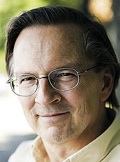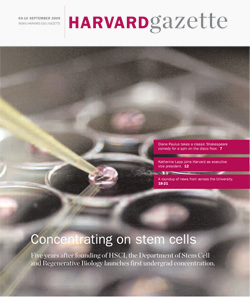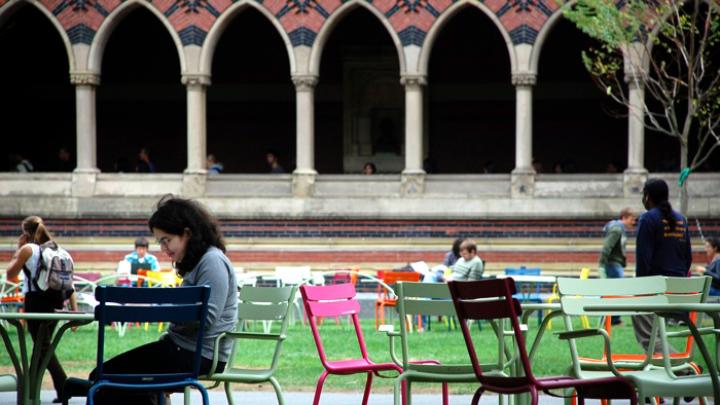The Common Spaces
The common spaces steering committee—chartered by President Drew Faust in the spring of 2008 to explore opportunities to enhance social life and enable artistic performances on campus—arranged this fall to distribute casual seating and tables around the Old Yard and elsewhere, and to sponsor open-air cultural events. The photo above, taken September 10, shows the lawn beside Memorial Hall. More ambitious aims (see "Task Force Seeks to Enhance Cambridge Campus"), including the possible physical reconfiguration of existing spaces near the Science Center, Holyoke Center, and the Malkin Athletic Center, will have to wait until the funding environment improves. In the meantime, it suddenly became easy to pull up a colorful chair, plop down, and chat on campus, at least while the experiment ran, from September 3 through the end of October.

Graduate School of Education
Jack W. Szostak
Nobel Hat Trick
Professor of genetics Jack W. Szostak, of Harvard Medical School (HMS) and Massachusetts General Hospital, has been named co-winner of the Nobel Prize in Physiology or Medicine, with Elizabeth H. Blackburn (University of California, San Francisco) and Carol W. Greider (Johns Hopkins School of Medicine). The three scientists were recognized for their fundamental discoveries concerning how chromosomes are protected by telomeres (the caps at the end of chromosomes) and the enzyme telomerase, enabling the genetic material to be copied during cell division without dangerous degradation. The work, previously recognized by the 2006 Lasker Award, has important implications for understanding both cancer and cell aging. Szostak’s current research focuses in part on the origins of life on earth and on the laboratory synthesis of cellular life. Szostak has been at HMS since 1979.… Separately, Thomas A. Steitz, Ph.D. ’67, Sterling professor of molecular biophysics and biochemistry at Yale and a Howard Hughes Medical Institute investigator, shared the Nobel Prize in Chemistry, for work on the structure and function of ribosomes, with Venkatraman Ramakrishnan (MRC Laboratory of Molecular Biology, Cambridge, England) and Ada E. Yonath (Weizmann Institute of Science, Rehovot, Israel). And President Barack Obama, J.D. ’91, won the Nobel Peace Prize.
New Year, New Traditions
The place may be 373 years old, but its people think young. On September 1, an innovative Freshman Convocation welcomed the “fourth College class of ’13” with celebratory music, speeches, and ritual that hinted at Commencement, the next time all 1,672 freshmen will officially gather again. Reinvention of the traditional convocation ceremony began last April, first envisioned by director for freshman programming Katie Steele; more than a hundred alumni attended to help out and cheer. Read a full description at http://harvardmagazine.com/breaking-news/new-harvard-college-freshman-convocation-tradition.…Homecoming was scheduled to arrive at Harvard for the first time on October 23-24. With The Game in New Haven this year, the Harvard Alumni Association encouraged grads to return for the Princeton game and special events on campus, including a tailgate.

Graduate School of Education
Katherine N. Lapp
EVP Succession
Katherine N. Lapp became executive vice president in early October, succeeding Edward C. Forst ’82, the first person to hold the job (from September 2008 until his departure, effective August 1, and subsequent return to Goldman Sachs). As the University’s chief administrative officer, Lapp will oversee financial, administrative, human-resources, and capital-planning functions in the central administration, as well as elements of the information-technology operation. She served as executive vice president for business operations for the University of California system from 2007 until her Harvard appointment; before that, she was executive director and chief executive officer of New York’s Metropolitan Transportation Authority. In announcing the appointment in late August, President Faust cited Lapp’s “extensive expertise in budget and finance, exceptionally strong credentials as a leader and reformer of systems and operations, and demonstrated success in the higher-education environment.”
Web Wow Factors

Harvard’s homepage, www.harvard.edu, has been given a makeover, part of the redesign and enhancement of the News Office’s Gazette publication (now reduced to biweekly frequency, but with much-enriched Web resources). The Harvard Worldwide website (www.worldwide.harvard.edu) has been souped up, too, with a searchable database (by school, area, and activity) so users can find individual faculty members with specific expertise, and with a much-enlarged pool of feature stories on University activities abroad—including student work in the field (see also “Immersed in Africa,” page 43).
Presidential Honorands
President Obama conferred the Medal of Freedom on 16 people at a White House ceremony on August 12, among them: former Supreme Court justice Sandra Day O’Connor, who was awarded the Radcliffe Institute Medal last June; former UN High Commissioner for Human Rights Mary Robinson, LL.M. ’68, LL.D. ’98; University of Chicago geneticist and cancer specialist Janet Davison Rowley, S.D. ’08; anti-apartheid leader Archbishop Desmond Tutu, LL.D. ’79; and U.S. Senator Edward M. Kennedy ’54, LL.D. ’08 (who was represented by his children, as he mourned the death of his sister Eunice Shriver and continued to fight the brain cancer that ended his life on August 25).
Research Briefs
The National Institutes of Health (NIH) renewed funding for the Harvard University Center for AIDS Research, one of 20 such sites in the United States, for basic-science and clinical investigations at the University and affiliated hospitals. The $18.1-million grant extends for five years. Separately, as part of its “expeditions in computing” program, the National Science Foundation awarded $10 million to support development of small-scale mobile robotic devices during the next five years. The work involves personnel from the School of Engineering and Applied Sciences and the Wyss Institute for Biologically Inspired Engineering (see “Tinker, Tailor, Robot, Fly,” January-February 2008, page 8, and “Engineering Bioengineering,” January-February, page 37). And Harvard School of Public Health established a Center for Communicable Disease Dynamics to model drug resistance, seasonal infectious diseases, and other issues; the work, directed by professor of epidemiology Marc Lipsitch (see “The SARS Scare,” March-April 2007, page 48), is underwritten by NIH, which will provide $15.6 million over five years.
Last of its Kind?

Even as fiscal realities crimped campus construction, steel rose for the Law School’s Northwest building. The superstructure frame should be completed by the end of December.
Nota Bene
Discoveries depository. Harvard’s online depository for faculty research, approved in early 2008 (see “Open Access,” May-June 2008, page 61), is open for business. DASH (the Digital Access to Scholarship at Harvard), an open-access repository, began with hundreds of works from more than 350 members of the research community (http://dash.harvard.edu). Participants include the Faculty of Arts and Sciences, Harvard Law School, Harvard Kennedy School, and Harvard Graduate School of Education. The DASH home page has search and browsing functions, with links to HMScholar, serving the Harvard medical, dental, and public-health communities, and other resources.
Rankings revised. Though Harvard and Princeton tied atop the U.S. News and World Report annual beauty contest, Washington Monthly’s newer college guide, released in early September, ranked Harvard eleventh among universities (behind six public institutions, Stanford, and the College of William and Mary). That evaluation emphasizes social mobility (recruiting and graduating lower-income students, as measured by the proportion receiving Pell Grants), research, and service (students entering the Peace Corps, in ROTC, etc.).
J-Term terms. The College posted an online application (with an October 15 deadline) for students who wish to be in residence during winter recess (December 22-January 3) and the new winter break (January 4-22) introduced by the University calendar adopted for this academic year. Because there will be no undergraduate academic programs during that time—and because House dining halls will be closed—those permitted to be on campus have already been limited to varsity athletes from 19 specified teams; international students; thesis writers “who absolutely must stay on campus to conduct their research,” with supporting permission from their adviser and concentration; people working in research labs; and certain others, for example in select public-service activities. The Extension School, ironically, will be piloting new intensive courses, running from January 5 to January 22.
Poverty and disease pioneers. The Prix Gailen USA committee conferred its 2009 Pro Bono Humanum Award on Barry R. Bloom, past dean of Harvard School of Public Health, and on Jeffrey D. Sachs ’76, Ph.D. ’80, JF ’81, formerly of Harvard’s economics department and now director of the Earth Institute at Columbia. They were recognized, respectively, for work on infectious diseases and on applying economic tools to alleviate poverty in Africa.









